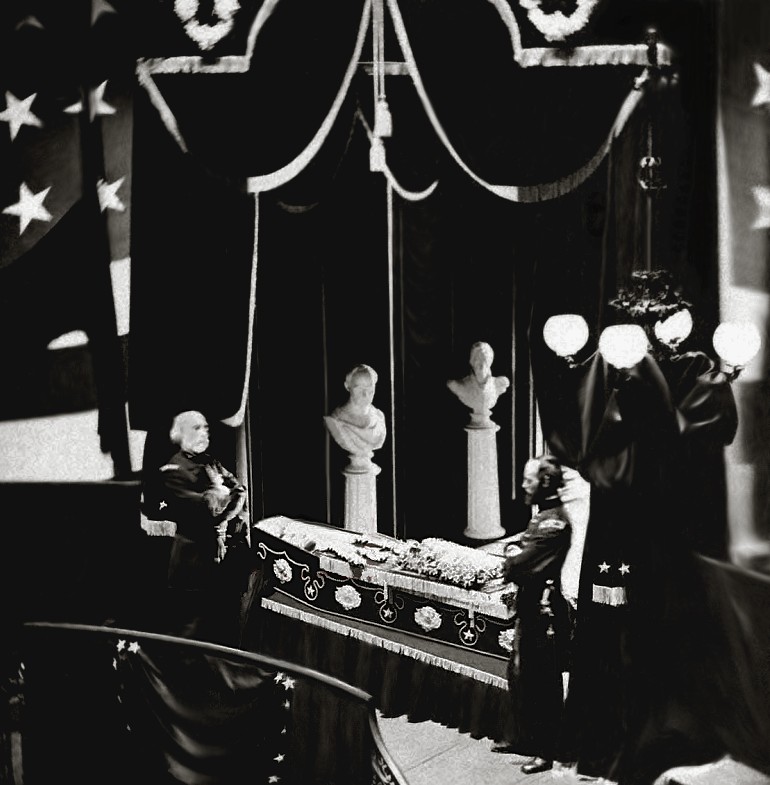Paola Pugsley explores the history of this now established custom
When faced with a crisis like the death of a much beloved sovereign, human beings tend to seek comfort in ritual. One of these is the tradition of the lying in state, when the deceased is laid in his or her coffin and mourners are invited to file past to pay their respects. One might think that this was a custom hallowed by the centuries. The truth is rather different.
The procedure refers to the placing of the body in an open or closed casket and displaying this in an opulent or solemn setting, as happened in Westminster Hall in the case of the late Queen Elizabeth II. The coffin stood on a raised plinth, covered by the royal standard and topped by a wreath, with the imperial crown, the golden orb and the sceptre on a purple cushion and huge candle stands all around. A selected contingent kept the vigil, dressed in elaborate unifoms, and a steady stream of mourners, some of whom had been queuing for hours, filed slowly past in complete silence. Only the shuffling of feet was heard.
But just how old is this custom? An early mention of the term ‘lying in state’, in the London Gazette in 1705, refers to Sophia Charlotte of Hanover, Queen Consort of Prussia, who died of pneumonia in that year. But there is no suggestion of crowds of commoners filing past to pay their respects. Her death remained a private matter.
That does not mean that the demise of a powerful leader was always kept private. Far from it. Monumental tombs, intended to endure forever, were a good way to announce the fact indelibly to everyone. One need only think of the pyramids. The populace did not visit them to pay their respects, as such, but they would certainly have stood before them in awe. Another, perhaps more subtle way of manipulating public perception was the use of conspicuous consumption. The target in this case was not so much the ordinary people but rival clans and power centres, who could be led to believe, seeing so much money lavished on a monument, that if so much disposable income was available, then there must surely be plenty more where it came from. This conspicuous consumption could take the shape of immense banquets, or the burial of vast riches with the deceased, as happened in the so-called Midas Tomb in Gordion ,Turkey. The procedure was one involving priests, relatives and officialdom. The populace played its role later, as tomb robbers.
Human sacrifice is also recorded. A man’s entire retinue of household servants might be bludgeoned to death and summarily embalmed, according to the latest research, to join their deceased master and ensure faithful, eternal service in the afterlife (mid-3rd millennium in Ur, Mesopotamia). But this system seems not to have endured. The Egyptians made do with moulded models, and the famous terracotta army was made of clay, not of people. For a long time the death of a ruler remained an affair between the surviving relatives and the religious authorities, but prestige might be lent by the architect of a monument. In Florence, Lorenzo the Magnificent had a simple tomb in San Lorenzo, but it was designed by Michelangelo.
The lying in state of a person of authority for the benefit not only of relatives and members of the apparatus of state but also of the common people, seems to have developed in the US, starting in 1852 with Henry Clay, a senator with a long and distinguished political career. In 1865 Abraham Lincoln was the first president to lie in state. The place of choice was the Capitol in Washington, DC. While we know when, however, it is not clear why it came about. Certainly the dramatic circumstances of Lincoln’s death played a part; moreover, as a young country looking for a common identity, the shared moment of grief acquired a momentum of its own in the United States and needed an outlet. The first statesman to be awarded the honour in the UK was Gladstone, in 1898, and from then on the practice spread and has now become routine. The first member of the British royal family to lie in state was Edward VII in 1910.

Another possible explanation for the custom of placing a body in an open casket is the fear of mistaken death. This encouraged people to delay burial for a few days to make sure that the departed was truly no more. The corpse would be kept in the house while well-wishers would come to pay their respects and comfort the family. While the medically accepted phenomenon of autoresuscitation (or Lazarus syndrome) is rare, the fear of being buried alive was and is very real. One can find all sort of examples on the web, including the case of a person who came back to life during his own autopsy.
Paola Pugsley is the author of Blue Guides to Crete and Turkey






